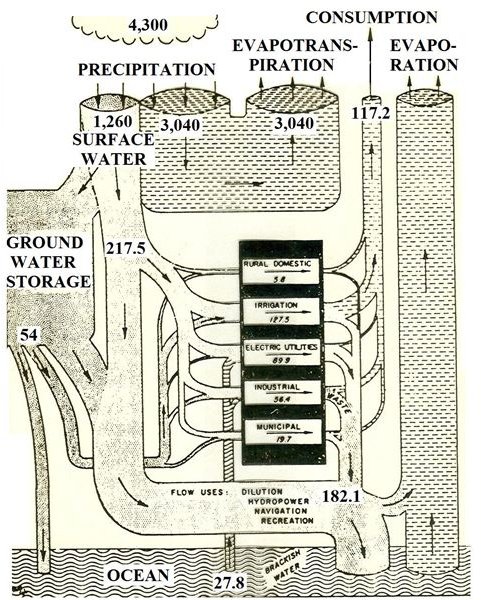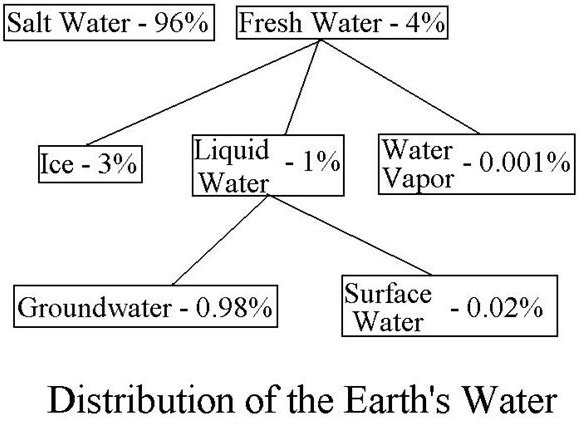Why is Groundwater Important? - The Reasoning Behind the Need
Introduction
Why, you may ask, is groundwater important? It’s buried underground where we can’t see it. Surely our activities at the Earth’s surface will not affect underground water. Nothing could be further from the truth! Groundwater is widely used in a variety of ways, like for residential water supply, industrial water supply and crop irrigation, anyplace that well water is used. What’s more, there is three times as much groundwater as our other source of fresh water, surface water. In addition, even though it is hidden underground, groundwater pollution is possible due to our activities at the Earth’s surface, and since groundwater interacts with surface water, contaminated groundwater can cause pollution of surface water.
Groundwater is our Most Abundant Fresh Water Resource
One reason why groundwater is important is that a large percentage of the Earth’s fresh water is in the underground aquifers. To put groundwater and surface water quantities into perspective, let’s consider the entire inventory of water at and near the Earth’s surface. The information in this section came from a 1970 article in the Scientific American. Full reference information is given at the end of the article.
First we’ll consider relative quantities of salt water and fresh water. If you’ve looked at a globe lately, you’ll probably predict that there is more salt water than fresh water. Indeed, there is a lot more salt water. Approximately 96% of the Earth’s water inventory is salt water in the oceans and seas. This leaves 4% of the Earth’s water as fresh water.
The fresh water is present as ice, liquid water, and water vapor. The polar ice caps contain a lot of ice. About 75% of the fresh water is ice (3% of the total water inventory) and 25% (1% of the total) is liquid water. Only about 0.001% of the Earth’s total water inventory is in the form of water vapor.
Some of the liquid fresh water (most of it in fact) is hidden underground as groundwater. About 98% of the Earth’s fresh water is groundwater. The other 2% of the Earth’s fresh water rmakes up all of the rivers, lake, reservoirs and streams, known as surface water. The diagram above shows the distribution of the major part of the Earth’s water inventory.
A couple of important forms of water are present as very small percentages of the total. About 0.0003% is soil moisture, which is available to plant roots and necessary for all plant life to grow. About 0.0000004% is in plants and animals. (That well known 75% of your body that is made up of water!)
Groundwater Pollution can Happen
Another reason that groundwater is important is that, even though it is underground, and we can’t see it, groundwater pollution can and does occur. Groundwater aquifers are recharged by precipitation percolating down through the soil. Similarly, other liquids dumped onto the ground can percolate down into the water, and water soluble pollutants dumped onto the ground or buried underground can be dissolved in rainwater percolating down into the aquifer. Some notable sources of groundwater pollution are nitrate from over-fertilized agricultural land and leakage of petroleum products like gasoline, diesel fuel, and fuel oil from underground storage tanks. Underground storage tanks are well regulated now, with requirements for monitoring and prevention of leakage, but there was a lot of leakage from such tanks 30 or 40 years ago, that caused pollution of soil and groundwater. This was prior to the realization by the institution of underground storage tank regulations that there was a problem.
Groundwater Interacts with Surface Water
Another reason why groundwater is important is that groundwater and surface water are not separate isolated resources. There is

interaction between the two. You may think that groundwater contamination isn’t really important - we can just avoid using the groundwater in the contaminated areas. However, a groundwater aquifer isn’t a static, non-moving underground reservoir. Groundwater moves more slowly than surface water, but groundwater does flow. There is groundwater flow into surface waters in some places and surface water infiltration into groundwater in some places. Thus, contaminated groundwater can cause contamination of a nearby river or stream. The figure at the right shows interactions between groundwater and surface water graphically. The numbers in the figure are approximately flows in billions of gallons per day in the U.S., as of the White 1969 publication referenced below, from which the figure was adapted. Also the article, ‘Hydrology (the Study of Water) 2: the Hydrologic Cycle,’ gives more discussion of the hydrologic cycle.
References
Penman, H.L., “The Water Cycle”, Scientific American, Vol 223, No. 2, pp 98-108, September, 1970.
White, G., Strategies of American Water Management, Univ. of Michigan Press, 1969.
